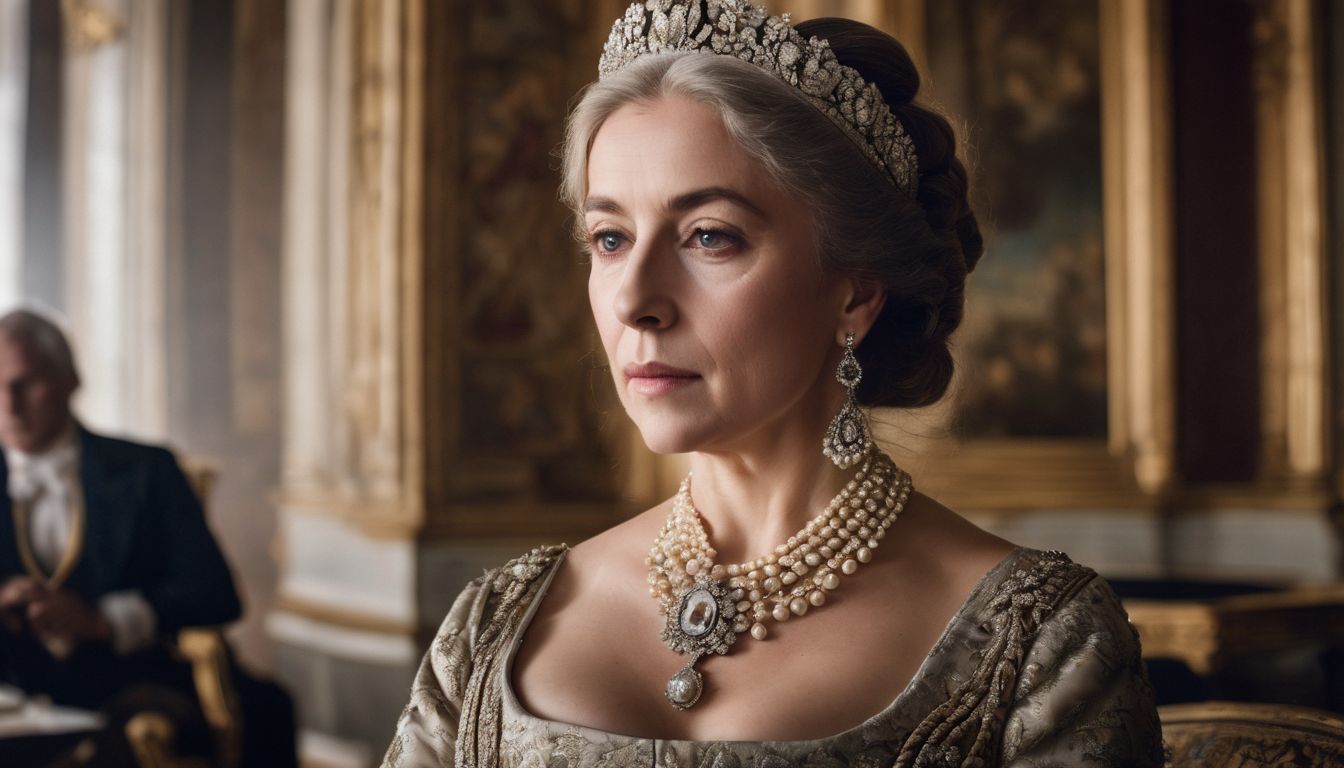Maria Theresa of Spain: The Queen of France

Updated On: December 05, 2023 by Raghda Elsabbagh
“This is the first chagrin she has ever given me.”
Louis XIV, King of France, after the death of his wife Maria Theresa of Spain
Delving into the grand European history, have you ever found yourself utterly bewitched by the intricate life of Maria Theresa of Spain? After research, we’re intrigued by how a humble Austrian archduchess ascended to become the queen consort of France. Maria Theresa of Spain emerges as a figure marked by both the whims of fate and the complex political intrigues of her time.
So grab your cup of tea and prepare for a journey through time as we explore our engaging protagonist’s early life. Are you ready to embark on this historical adventure together?

Key Takeaways
- Maria Theresa of Spain was born into Spanish and Portuguese royalty and later married King Louis XIV of France, solidifying an alliance between the two countries.
- She played a significant role in European politics, using her position as a queen consort to strengthen ties between France and Spain through royal marriage diplomacy.
A Royal Beginning: Birth and Lineage of Maria Theresa of Spain
Gracing the world on 10 September 1638, in the opulent halls of the El Escorial palace near Madrid, Maria Theresa was an infanta of the Spanish and Portuguese royalty. She hailed from the illustrious House of Habsburg, a family renowned for its influence on European politics and culture.
Her father, Philip IV of Spain, and her mother, Queen Elisabeth of France, represented the merging of two powerful dynasties. So, from the time she was born, Maria Theresa had a significant role to play in history.
She was not just any baby girl; she was an Archduchess! That’s a fancy title that only very significant ladies have, and one day, this Spanish and Portuguese princess would grow up to be the queen of two different countries and make a mark on all of Europe!
Tragedy Strikes: The Loss of Mother and Brother
However, fate dealt Maria Theresa an early blow when, at the tender age of six, she lost her mother. Two years later, in 1646, tragedy struck again with the death of her older brother, Balthasar Charles. He was not only Maria Theresa’s sibling but also the heir to Philip IV’s throne. Balthasar was promised to marry his cousin, Mariana of Austria. In European monarchies, these royal intermarriages were accepted to continue the royal lineages, even if they ventured into the territory of what today would raise eyebrows.
Balthasar’s death culminated in an unconventional marriage between her father, Philip IV, and her cousin, Mariana of Austria, in 1649. Bound by duty and tradition, uncle and niece entered a union that, though deemed incestuous in modern times, was an accepted norm in the royal courts of the 17th century.
Lonely Childhood of Maria Theresa of Spain Amidst Spanish Royalty
Yet, amid these familial arrangements, Maria Theresa’s childhood was far from idyllic. The loss of her mother and the subsequent marriage of her father to her cousin were tremorous shifts that left her grappling with solitude. Neglected by her stepmother, who was a mere four years older than her, Maria Theresa found herself navigating the corridors of the Spanish court with minimal familial support.
The echoes of her lonely childhood would resonate through the chapters of her life, shaping the woman who would later become Queen of France. In the solitude of her early years, seeds of strength were sown, preparing her for the challenges and triumphs that awaited her on the grand stage of European royalty.
A Royal Union: Maria Theresa’s Marriage to Louis XIV of France
The backdrop of her early years was the lingering conflict between Spain and France, a tension that would significantly shape her destiny. The Thirty Years War, a devastating conflict that spanned from 1618 to 1648, set the stage for the negotiations leading to the Treaty of the Pyrenees.
This treaty, signed in 1659, not only aimed to end hostilities but also proposed a strategic solution to establish peace—a union between the Habsburgs, the royal families of Spain, and the Bourbons, the royal families of France. The proposal was to secure the marriage of Maria Theresa to Louis XIV, the powerful and charismatic French king known as the “Sun King.” Though rooted in political pragmatism as a means to solidify peace and end years of conflict, this proposal sparked resistance from those wary of such a cross-border alliance.
A Spanish Queen in a French World: The Transition to the French Court
Maria Theresa of Spain’s life took a momentous turn when she became the queen consort at the age of twenty-two through her marriage to Louis XIV of France, her double first cousin. This union, consummated in 1660 in the picturesque Saint-Jean-de-Luz, was not but a political alliance between Spain and France to strengthen their ties.
Maria Theresa of Spain faced the challenge of adapting to the vibrant French court, a stark contrast to her more reserved Spanish upbringing. The French court, known for its love of innovation, fashion, dancing, and wit, was a cultural shift for Maria Theresa, who was inherently shy and preferred a smaller circle of companions. Despite her introverted nature and lack of fashion-forward flair, she admirably fulfilled her role as Queen to Louis XIV.
Coping with Louis XIV’s Affairs
The marriage, however, was far from a fairy tale. The strains in Maria Theresa’s marriage were evident due to Louis XIV’s numerous love affairs and courtly excesses that began after their first year of marriage, a source of distress for Maria Theresa. King Louis XIV did little to uphold the ideals of marital fidelity. However, he protected Maria Theresa from disrespect by other women in court, scolding them when they failed to show her the required respect.
Surprising Alliances: Maria Theresa of Spain and Mother-in-Law
As Maria Theresa navigated the complexities of court life, she found an unexpected ally in her mother-in-law, Anne of Austria, who was also her paternal aunt. She and her mother-in-law supported charitable causes and prayed together. Maria Theresa’s social engagements were not confined to the palace; she actively participated in philanthropy and cultural initiatives.
Failing Peace, Achieving Heirs: Maria Theresa as a Mother
While Maria Theresa may not have succeeded in achieving the peace intended by royal marriages, as France and Spain remained embroiled in conflicts, she did fulfil the second aspect by giving birth to six children, three of whom were sons. The first, Louis, was born on 1 November 1661, and notably, he was the only child to outlive her.
Unfortunately, her other children faced untimely deaths, with her eldest surviving daughter living for only five years and the rest succumbing within weeks of birth. Despite the challenges and losses, Maria Theresa’s role as a mother and a queen showcased her resilience in navigating the complexities of both the French court and her marriage.
Maria Theresa’s Enduring Legacy: A Queen of Strength and Resilience
Maria Theresa’s life became a delicate balance between the grandeur of Versailles and the shadows cast by Louis XIV’s infidelities. As she faced the trials of court life, Maria Theresa’s piety and virtue shone through, earning her respect and admiration even in the face of adversity. Her political influence remained limited, except for brief regencies during her husband’s absences, particularly in 1667, 1672 during the Franco-Dutch War, and 1678, when she temporarily assumed the role of regent.
Despite being relegated to the sidelines by the king’s mistresses, including the infamous Françoise-Athénaïs, Marquise de Montespan, she exhibited strength and resilience. She continued to tolerate Louis XIV’s prolonged infidelity. However, her influence waned further when Madame de Maintenon, the governess of Montespan’s illegitimate children, came to succeed her mistress in the king’s love.
Chocolate Makes its Way to France
The introduction of chocolate to France can be attributed to Maria Theresa of Spain. After the Spanish conquest of the Aztec Empire, cacao made its way to Europe, opening a new chapter in culinary history. Maria Theresa, a genuine lover of chocolate, presented her future husband, Louis XIV, with a lavishly decorated chest containing this exotic delight as an engagement gift. Enchanted by the rich and flavourful treat, Louis XIV became an instant enthusiast, propelling chocolate into the spotlight of the French court.
Maria Theresa’s Death
Tragedy struck in 1683 when Maria Theresa succumbed to illness at the age of 44. “This is the first chagrin she has ever given me,” were Louis XIV’s poignant words after her death.
With only one of her six children, Louis, le Grand Dauphin, surviving to adulthood, the legacy of Maria Theresa endured through her grandson, Philip V, who would later inherit the Spanish throne in 1700, setting the stage for the War of the Spanish Succession. This conflict reshaped the geopolitical landscape of Europe and established the House of Bourbon as the ruling dynasty of Spain.
With its twists of fate, royal intrigues, and personal trials, Maria Theresa’s life is a captivating tale of a woman who navigated the treacherous waters of 17th-century European politics. Beyond the grandeur of Versailles and the royal entanglements, she remains a resilient queen whose story is etched in the annals of history.
Her legacy extends beyond her time, influencing the course of European history and leaving an indelible mark on the tumultuous era in which she lived. Maria Theresa of Spain, a queen of strength, resilience, and enduring grace, stands as a testament to the indomitable spirit of royalty in a bygone era.






